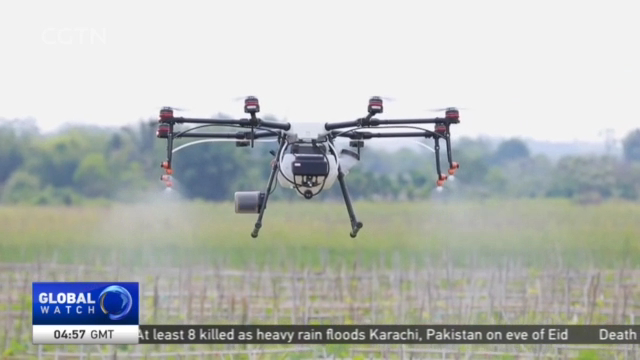
13:29, 12-Aug-2019
Smart Agriculture: Drone spraying: The future of China's agricultural modernization
Updated
14:02, 12-Aug-2019

Keeping China's crops safe from pests is tedious work. Yet thanks to some major technological advancements, it's getting easier and more efficient. A group of scientists in southern China are behind the efforts to deploy more drones for this important task. CGTN Reporter Ge Yunfei has the story.
China's pest control is a costly business. In 2016, over 1.8 million tons of pesticides were consumed across the country, accounting for one-third of the world's total amount. But since then, China's pesticide use has declined. One reason? Drones.
DENG JIAJIAN, MANAGER NONGFEIKE AGRICULTURAL TECHNOLOGY, HAINAN "Using drones to spray pesticides is 30 times more efficient than doing it the traditional way. And we have also found that it cuts pesticide usage by quarter. For each drone to carry out its task, it takes only 2 liters of water per acre in China. But with humans spraying, it takes 60 liters of water."
37-year-old Wang Juan is a postdoctoral fellow at South China Agricultural University. She and her team have been studying precision agricultural aviation pesticide spraying technology since 2014.
WANG JUAN, POSTDOCTORAL FELLOW SOUTH CHINA AGRICULTURAL UNIVERSITY "Our goal is to achieve precise spaying. First, we use spectral cameras installed on the drones to scan farmland and generate prescription pictures that can show different levels of insect damage to the farmland. Then the drone can control the number of pesticides sprayed on the crops according to those damage levels."
To achieve their goal, a huge amount of detailed work needs to be carried out. Wang and the students have to fly all over the country to carry out experiments on different crops and collect the raw data piece by piece.
WANG JUAN, POSTDOCTORAL FELLOW SOUTH CHINA AGRICULTURAL UNIVERSITY "Aviation spraying is a very mature concept in the US, but it's still a new thing in China. So the industry here doesn't have an operation standard. What's more complicated is that the standard for each crop in each stage of growth is different. So we're now trying to establish a standard model for China's drone spraying."
And China's world-leading drone industry is also expanding its arena to the farmlands. DJI, the world's largest drone-maker, says they have sold more than 10,000 agricultural drones in the past three years. And the company keeps adding more cutting-edge technologies to pesticide spraying.
LI XINGNONG ENGINEER, DJI "With digital beamforming technology, it can realize 3D point cloud imaging, which can effectively identify complex farmland scenes and achieve autonomous obstacle flight. The radar supports terrain slope and mountain slope detection, and the drone can fly in a simulated manner."
With an all-weather data imaging radar that can monitor farmland environments, it can spray pesticide over a 100-thousand square meters area in one hour, a 67% increase over its drone predecessors. Behind all of these innovations is the dedication of hundreds of engineers. Li Xingnong, an engineer from DJI, is one of them.
LI XINGNONG ENGINEER, DJI "I spent six months traveling across China to collect data of different crops. It's hard, but you're participating in a great cause of modernizing and reforming the traditional agriculture production mode. It makes me proud."
By 2018, there were over 30,000 agricultural drones in China, a nearly four-fold increase from a year earlier. This rampant growth is also boosting the wild imaginations within China's smart agriculture industry. Ge Yunfei, CGTN, from Hainan and Guangdong Provinces.
SITEMAP
Copyright © 2018 CGTN. Beijing ICP prepared NO.16065310-3
Copyright © 2018 CGTN. Beijing ICP prepared NO.16065310-3